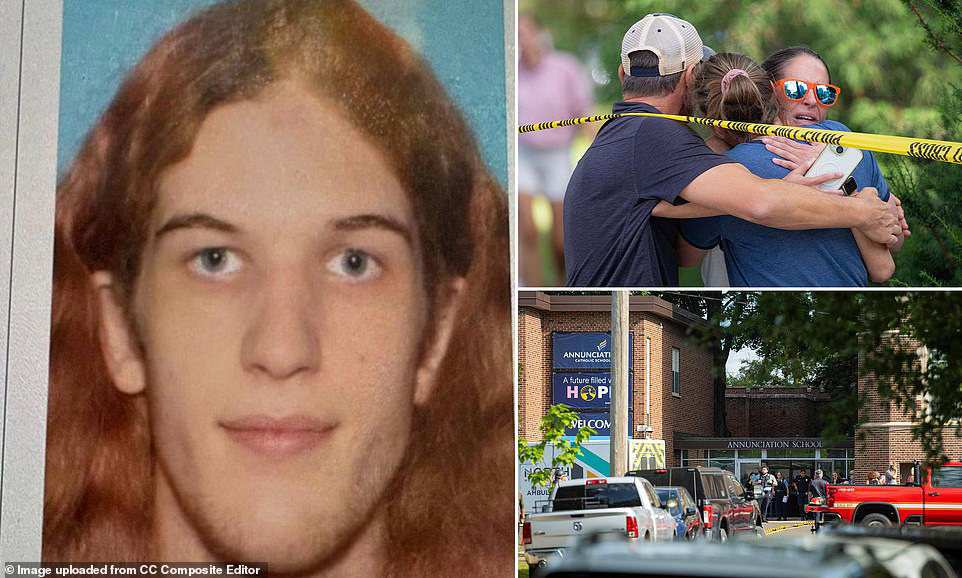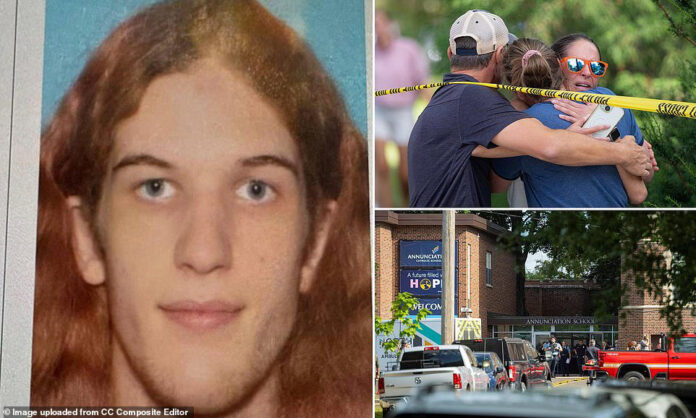Teacher’s CHILLING Warning About Minneapolis School Sh*oter Ignored?! 😱
A former teacher’s haunting revelation about the Minneapolis school shooter is sending shockwaves through the nation! Disturbing signs of strange behavior were spotted YEARS ago, but did anyone act on them? 😲 What did she see, and why is it coming to light now? This heartbreaking story will leave you speechless! 💔
👉 Click the link to uncover the shocking details and what could have been done!

On August 27, 2025, a horrific shooting at Annunciation Catholic School in Minneapolis claimed the lives of two children, Fletcher Merkel (8) and Harper Moyski (10), and injured 18 others, including 14 children. The shooter, identified as 23-year-old Robin Westman, a former student of the school, died of a self-inflicted gunshot wound. In the aftermath, a former teacher, Sarah Reely, came forward with a sobering revelation: years earlier, she had noticed and reported concerning signs of self-harm in Westman, then a high school student. This claim, reported by CBS Minnesota on August 30, 2025, has sparked intense debate about missed warning signs, mental health support in schools, and the broader challenge of preventing mass shootings. This article examines Reely’s observations, the shooter’s background, and the systemic issues that may have allowed such a tragedy to unfold.
The Teacher’s Warning: Sarah Reely’s Account
Sarah Reely, who taught art at a Twin Cities high school attended by Westman, shared her chilling recollection in a Facebook post on August 28, 2025, as reported by NBC News. She noted that in 2017, when Westman was a student in her class at an all-boys prep school, she observed signs of self-harm on the student’s arm. “Self-harm is either a cry for help, an indication of self-hate, or both. But it’s always a sign something is wrong,” Reely wrote, emphasizing that she reported her concerns to school authorities at the time. She expressed regret, wondering if more could have been done, but noted that she was unaware of any follow-up actions after her report.
Reely’s disclosure aligns with broader patterns identified in mass shooting cases, where retrospective accounts often reveal early warning signs. A former classmate, Josefina Sanchez, told ABC Minneapolis affiliate KSTP that Westman had few friends and displayed “odd obsessions” during grade school, including writing in a coded blend of Cyrillic letters—a behavior echoed in Westman’s 2025 diary entries. These accounts paint a picture of a troubled individual whose struggles were noticed but not adequately addressed.
Who Was Robin Westman?
Robin Westman, born Robert Westman, legally changed their name in 2020 at age 17, identifying as female, per Minnesota court records. Westman attended Annunciation Catholic School, where their mother, Mary Grace Westman, worked until her retirement in 2021. Minneapolis Police Chief Brian O’Hara confirmed that Westman had a connection to the school and church, having attended Mass there and conducted “preoperational surveillance” within three months of the attack. This planning was evident in a YouTube “manifesto” Westman timed to publish during the shooting, which included a sketch of the church’s sanctuary titled “Annunciation from memory” in Cyrillic, as reported by BBC News.
Investigators described Westman as having a “deranged obsession with previous mass shooters” and a desire to “watch children suffer.” Writings and videos revealed hatred toward multiple groups, including the Jewish community, Catholics, and President Donald Trump, with antisemitic phrases and Holocaust references scrawled on weapons and in notes. Despite this, O’Hara noted that Westman had no extensive criminal history, only a traffic ticket, and legally purchased the three firearms used—a semiautomatic rifle, a pump-action shotgun, and a pistol. Approximately 120 shell casings were recovered, indicating the scale of the attack, which targeted children during a back-to-school Mass.
Missed Opportunities: Mental Health and School Systems
Reely’s report of self-harm in 2017 raises critical questions about how schools handle mental health concerns. Self-harm is a recognized red flag for deeper psychological issues, often linked to depression, anxiety, or suicidal ideation. According to a 2025 American Psychological Association study, early intervention for self-harm can prevent escalation to violent behavior, but schools often lack the resources or protocols to follow through. Reely’s uncertainty about the outcome of her report suggests a gap in communication or action, a common issue in underfunded school systems.
Westman’s behavior in high school—described as disruptive and socially isolated by a former Annunciation employee—further indicates missed opportunities. The employee, speaking anonymously to NBC News, recalled Westman’s frequent visits to the principal’s office and noted that Mary Grace Westman had expressed concerns about her child’s social and behavioral issues. Yet, O’Hara stated that authorities found no record of Westman being confined for mental health issues, suggesting that any interventions were either absent or insufficient.
The FBI’s investigation, led by Director Kash Patel, classified the attack as “domestic terrorism and a hate crime targeting Catholics.” Westman’s writings, described by Acting U.S. Attorney General Joseph Thompson as reflecting “pure, indiscriminate hate,” point to a complex psychological profile. The use of Cyrillic letters and references to past mass shooters suggest a fixation on notoriety, a trait identified in a 2023 FBI report on active shooters, which notes that many perpetrators seek infamy through their actions.
Systemic Challenges: Gun Access and Warning Signs
Westman’s ability to legally purchase three firearms underscores the challenge of balancing Second Amendment rights with public safety. Minnesota’s gun laws, while stricter than some states, do not prohibit purchases based on mental health concerns unless an individual has been involuntarily committed, per a 2025 Minneapolis Star Tribune analysis. Drew Evans, superintendent of the Bureau of Criminal Apprehensions, emphasized that public reporting of concerning behavior is critical, stating, “That did not happen in this case.” This gap highlights the need for better mechanisms to flag individuals exhibiting red flags, such as Westman’s YouTube videos displaying weapons and violent rhetoric.
First Lady Melania Trump’s August 2025 statement on X, calling for “pre-emptive intervention” and behavioral threat assessments, echoed this sentiment. She noted that “early warning signs are often evident, with many individuals exhibiting concerning behaviors and making violent threats online.” Yet, implementing such systems is fraught with challenges, including privacy concerns and the risk of overreach, as discussed in a 2025 New York Times op-ed on school safety.
Community and Policy Responses
The Minneapolis shooting reignited calls for gun control, with Mayor Jacob Frey advocating for bans on assault weapons and high-capacity magazines. “There is no reason someone should be able to reel off 30 shots before they even have to reload,” Frey said, as reported by The Guardian. However, Minnesota’s politically divided legislature and Republican-controlled Congress make national reform unlikely, per BBC News. Advocates like Moms Demand Action and Protect Minnesota rallied at city hall, urging action to prevent future tragedies.
The community response was equally poignant. A vigil at the Academy of Holy Angels drew hundreds, with Archbishop Bernard Hebda praising the courage of students who shielded classmates. Hennepin Healthcare treated 10 victims, with one child remaining in critical condition as of August 30, 2025, per KARE. Children’s Minnesota discharged six of seven child victims, reflecting the physical toll but also the resilience of survivors.
The Broader Context: Preventing Future Tragedies
Reely’s plea for “urgent changes to how mental health is handled in schools” resonates with national discussions on school safety. The 2025 shooting at Annunciation Catholic School joins a grim list of attacks at religious institutions, including the 2023 Covenant School shooting in Nashville, where a former student killed six. A 2024 Violence Prevention Project Research Center study found that 70% of school shooters exhibit warning signs, such as social isolation or fascination with violence, yet only 20% receive intervention before acting.
The role of social media in amplifying violent ideation is another critical factor. Westman’s YouTube manifesto, taken down by the FBI, mirrors cases like the 2019 Dayton shooter, who posted violent content online. Platforms face increasing pressure to monitor such content, but as a 2025 PBS News report noted, the volume of user-generated material makes proactive detection difficult.
Conclusion: A Call for Action
Sarah Reely’s revelation about Robin Westman’s self-harm in 2017 underscores a tragic truth: warning signs were present, but systemic gaps prevented effective intervention. The Minneapolis shooting highlights the urgent need for robust mental health support in schools, improved reporting mechanisms for concerning behaviors, and stronger gun control measures. While Westman’s motives—rooted in a fascination with mass shootings and indiscriminate hate—may never be fully understood, the tragedy demands reflection on how society can better protect its most vulnerable.
As Minneapolis mourns Fletcher Merkel and Harper Moyski, the words of their parents echo: “Give your kids an extra hug and kiss today.” Reely’s call to action, urging that the tragedy not end with “flowers and vigils,” is a reminder that preventing future shootings requires collective effort—across schools, communities, and policymakers—to heed the warning signs that were missed.
